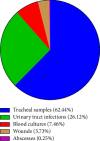Comprehensive Analysis of Virulence Genes, Antibiotic Resistance, Biofilm Formation, and Sequence Types in Clinical Isolates of Klebsiella pneumoniae
- PMID: 39734766
- PMCID: PMC11671628
- DOI: 10.1155/cjid/1403019
Comprehensive Analysis of Virulence Genes, Antibiotic Resistance, Biofilm Formation, and Sequence Types in Clinical Isolates of Klebsiella pneumoniae
Abstract
Background: The rise in multidrug-resistant pathogens poses a formidable challenge in treating hospital-acquired infections, particularly those caused by Klebsiella pneumoniae. Biofilm formation is a critical factor contributing to antibiotic resistance, enhancing bacterial adherence and persistence. K. pneumoniae strains vary in virulence factors, influencing their pathogenicity and resistance profiles. This study aimed to comprehensively analyze virulence factors, antibiotic resistance patterns, and biofilm formation in clinical isolates of K. pneumoniae from Hamadan hospitals. Moreover, the study explored the molecular epidemiological relationships among isolates using multilocus sequence typing (MLST) to uncover the genetic diversity associated with resistance and virulence. Materials and Methods: Between December 2022 and April 2024, 402 K. pneumoniae isolates were collected from clinical samples, including urine, tracheal aspirates, blood, wounds, and abscesses, in teaching hospitals in Hamadan. Initial culturing was performed on blood agar and MacConkey agar, and isolates were identified using biochemical tests. Antimicrobial susceptibility testing followed CLSI, employing the Kirby-Bauer disk diffusion method with 10 antibiotics. Biofilm formation was assessed using the microtiter plate method, and virulence genes were detected by PCR. MLST analysis was conducted on 10 selected isolates based on their virulence gene profiles and resistance patterns. Result: Of the 456 clinical isolates analyzed, 402 (88.15%) were identified as K. pneumoniae, predominantly isolated from tracheal samples (251/402, 62.44%), followed by urine (105/402, 26.12%), blood (30/402, 7.46%), wounds (15/402, 3.73%), and abscesses (1/402, 0.25%). Antibiotic resistance rates revealed high resistance to cefepime (356/402, 88.55%), imipenem (345/402, 85.82%), and ceftazidime (305/402, 75.87%), while resistance to amikacin (165/402, 41.04%) and piperacillin-tazobactam (75/402, 18.65%) was comparatively lower. Biofilm formation varied among the isolates, with 17/402 (4.22%) forming strong biofilms, 104/402 (25.87%) moderate biofilms, 180/402 (44.78%) weak biofilms, and 101/402 (25.12%) showing no biofilm production. Virulence gene analysis indicated high prevalence rates for mrkD (396/402, 98.50%), fimH1 (351/402, 87.31%), and entB (402/402, 100%), while genes like irp-1 (151/402, 37.56%) and irp-2 (136/402, 33.83%) were less common, and hylA and cnf-1 were absent. MLST analysis of 10 selected isolates identified sequence types ST147 (5/10, 50%), ST11 (3/10, 30%), and ST15 (2/10, 20%). Conclusion: K. pneumoniae demonstrates notable biofilm-associated antibiotic resistance, supported by a significant association with XDR strains, along with a diverse array of virulence gene profiles. The study underscores the importance of understanding molecular epidemiology for effective management of hospital infections, emphasizing the need for targeted surveillance and infection control measures.
Keywords: Klebsiella pneumoniae; antibiotic resistance; biofilm; molecular epidemiology; virulence factors.
Copyright © 2024 Mohsen Nazari et al.
Conflict of interest statement
The authors declare no conflicts of interest.
Figures



Similar articles
-
Antibiotic resistance and its correlation with biofilm formation and virulence genes in Klebsiella pneumoniae isolated from wounds.J Appl Genet. 2024 Dec;65(4):925-935. doi: 10.1007/s13353-024-00893-w. Epub 2024 Jul 20. J Appl Genet. 2024. PMID: 39031267
-
Correlation between antimicrobial resistance and biofilm formation capability among Klebsiella pneumoniae strains isolated from hospitalized patients in Iran.Ann Clin Microbiol Antimicrob. 2021 Feb 15;20(1):13. doi: 10.1186/s12941-021-00418-x. Ann Clin Microbiol Antimicrob. 2021. PMID: 33588850 Free PMC article.
-
Antibiotic Susceptibility Patterns and Virulence Profiles of Classical and Hypervirulent Klebsiella pneumoniae Strains Isolated from Clinical Samples in Khyber Pakhtunkhwa, Pakistan.Pathogens. 2025 Jan 15;14(1):79. doi: 10.3390/pathogens14010079. Pathogens. 2025. PMID: 39861040 Free PMC article.
-
[Investigation of various virulence factors of Klebsiella pneumoniae strains isolated from nosocomial infections].Mikrobiyol Bul. 2017 Oct;51(4):329-339. doi: 10.5578/mb.59716. Mikrobiyol Bul. 2017. PMID: 29153063 Turkish.
-
Biofilm Resilience: Molecular Mechanisms Driving Antibiotic Resistance in Clinical Contexts.Biology (Basel). 2025 Feb 6;14(2):165. doi: 10.3390/biology14020165. Biology (Basel). 2025. PMID: 40001933 Free PMC article. Review.
Cited by
-
Molecular characteristics and antimicrobial susceptibility of carbapenem-resistant Klebsiella pneumoniae in a multicenter study in Ningbo, China.Front Microbiol. 2025 Jul 21;16:1628592. doi: 10.3389/fmicb.2025.1628592. eCollection 2025. Front Microbiol. 2025. PMID: 40761276 Free PMC article.
-
Enhancing antibiotic therapy through comprehensive pharmacokinetic/pharmacodynamic principles.Front Cell Infect Microbiol. 2025 Feb 25;15:1521091. doi: 10.3389/fcimb.2025.1521091. eCollection 2025. Front Cell Infect Microbiol. 2025. PMID: 40070375 Free PMC article. Review.
References
LinkOut - more resources
Full Text Sources
Molecular Biology Databases
Miscellaneous

